Bài giảng Thị trường bảo hiểm - Module 2 - Nguyễn Tiến Hùng
ĐỊNH NGHĨA QUẢN TRỊ RỦI RO
Definition of Risk Management
“Quản trị rủi ro là một môn học về việc chấp nhận cuộc sống với
khả năng các biến cố trong tƣơng lai có thể nguy hiểm”
Risk Management is a subject which study about the possibility that a future occurrence
may cause harm or losses
“Quản trị rủi ro nhằm bảo vệ tài sản của doanh nghiệp, trong điều
kiện giá phí hợp lý nhất, chống laị những tổn thất có thể tác hại
đến quá trình hoạt động của một doanh nghiệp”
Risk Management is to protect the enterprise in such the way to reduce the cost of the loss or
no-loss risks, to prevent the loss and the impact of potential financial loss in the business
operation.
“Quản trị rủi ro là việc quản lý giá phí toàn bộ của các rủi ro có
thể bảo hiểm hay không trong một doanh nghiệp”.
Risk management is to control the general cost of insurable risks in the company operation
Các định nghĩa chƣa đạt đƣợc mức độ thống nhất cao.
All definitions have not yet got the highest level of agreement
Nhiều vấn đề mới lại đƣợc đặt ra:
Many challenges expose such as:
Liệu có còn ý nghĩa không việc phân loại rủi ro thuần và rủi ro đầu cơ?
Whether it is still meaningful to classify “pure risk “ and “speculative risk”
Quản trị rủi ro phải chăng là một phƣơng pháp, một khoa học, hay một nghệ
thuật?
Risk management is a method , a science or an art?
Phạm vi áp dụng của nó phải chăng chỉ giới hạn trong những rủi ro có thể bảo hiểm, chỉ
trong phạm vi doanh nghiệp hay có thể mở rộng đối với các hình thức tổ chức khác?
The risk management concept was developed in the managing of insurable risks, is it a new principle
applicable to management generally?
Ngƣời quản trị rủi ro liệu có thể thật sự thực hiện chức năng quản trị rủi ro
một cách độc lập không?
Risk managers can implement the function of risk management independently?
Khái niệm quản trị rủi ro chƣa bị “đông” lại mà sẽ còn phát triển.
The concept for risk management was not a buzz word but in future development
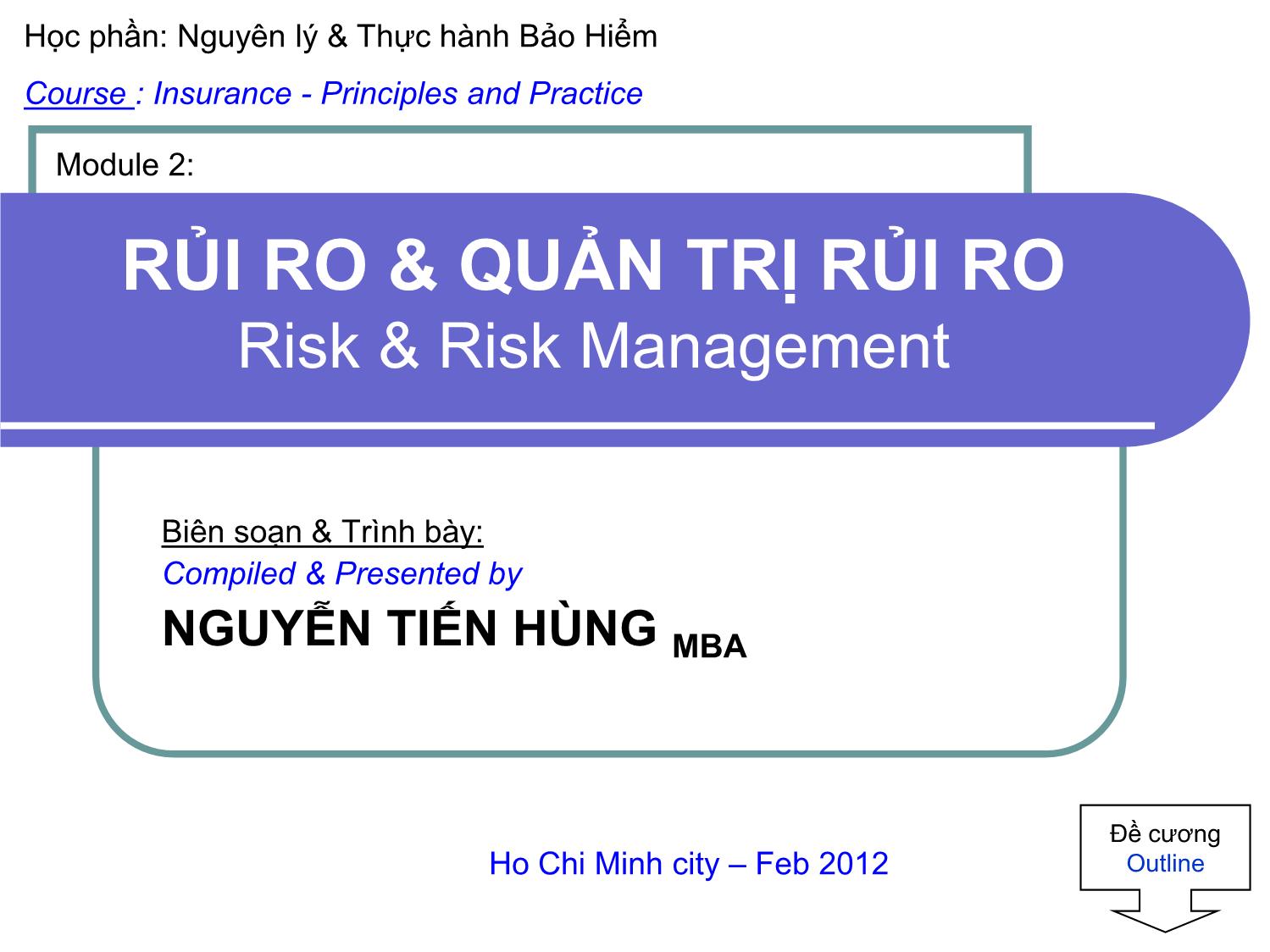
Trang 1
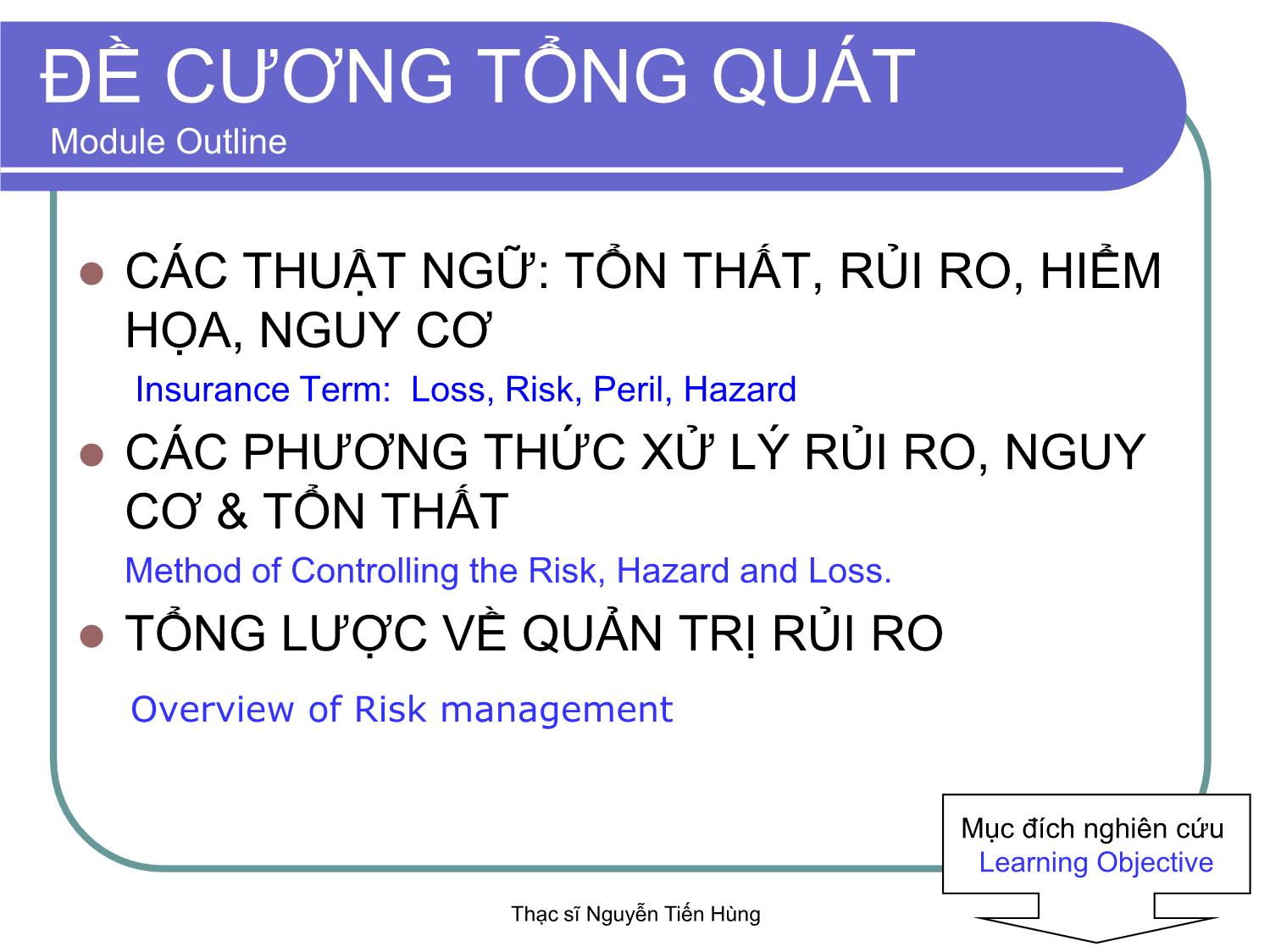
Trang 2
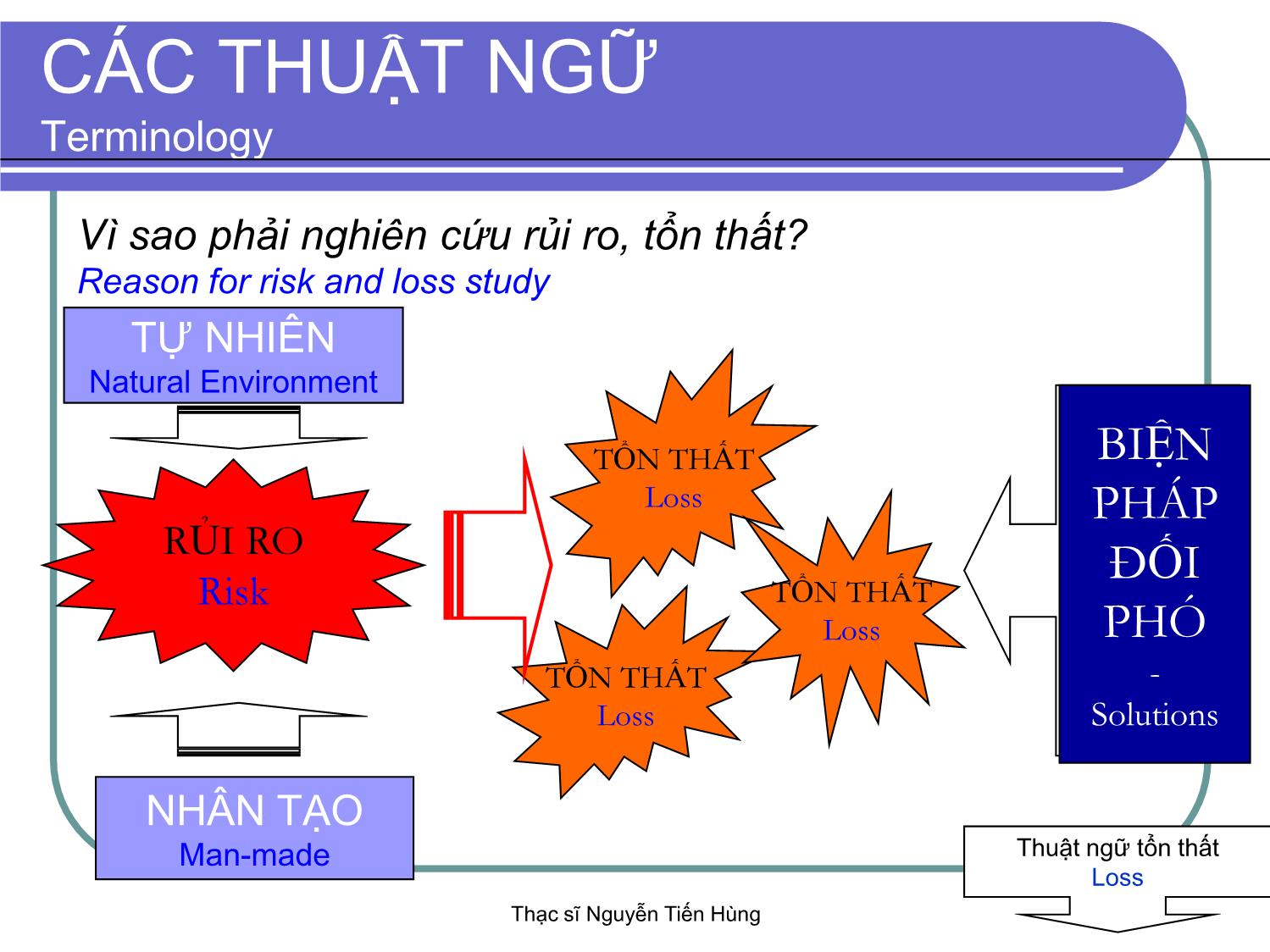
Trang 3
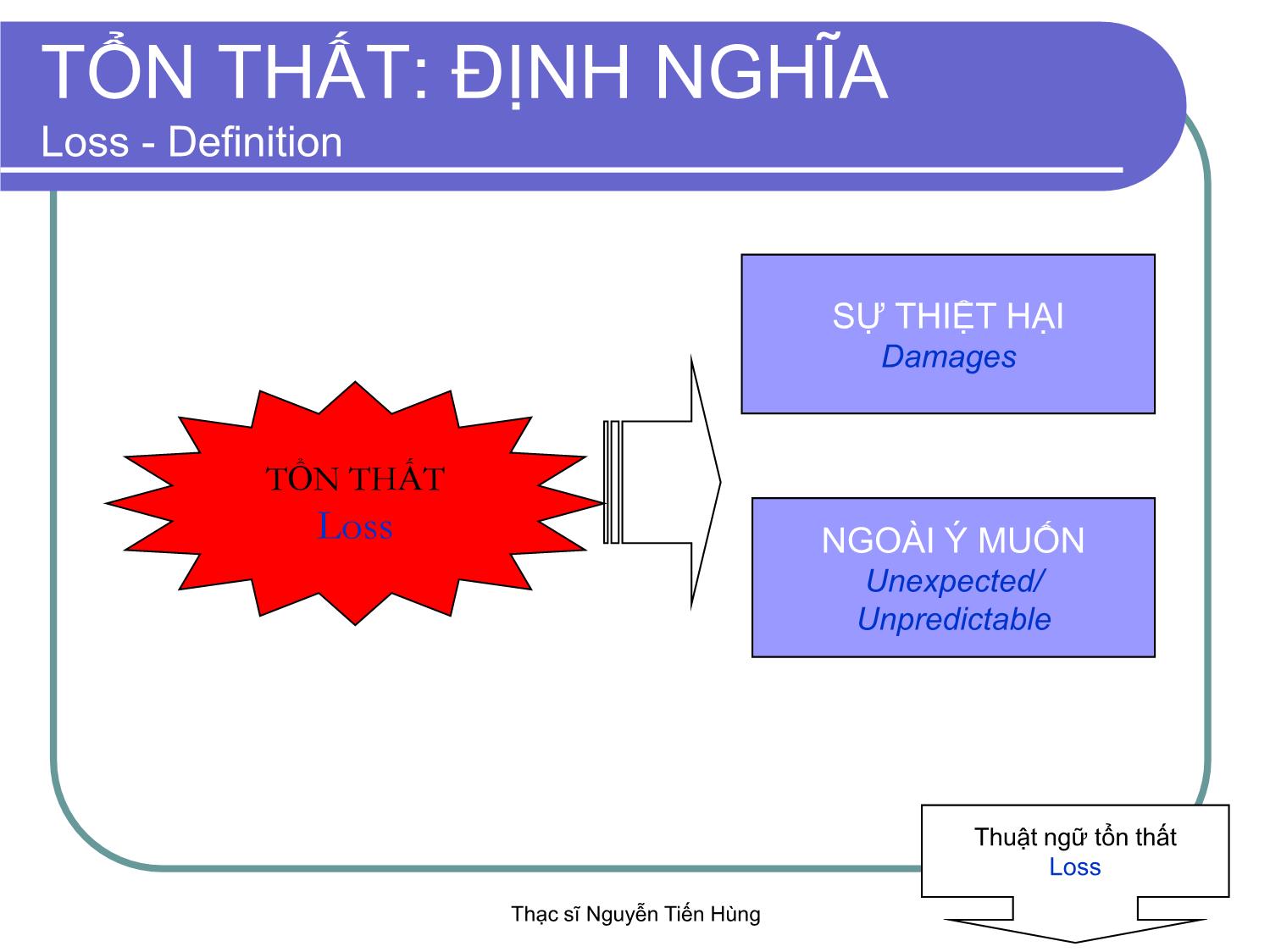
Trang 4
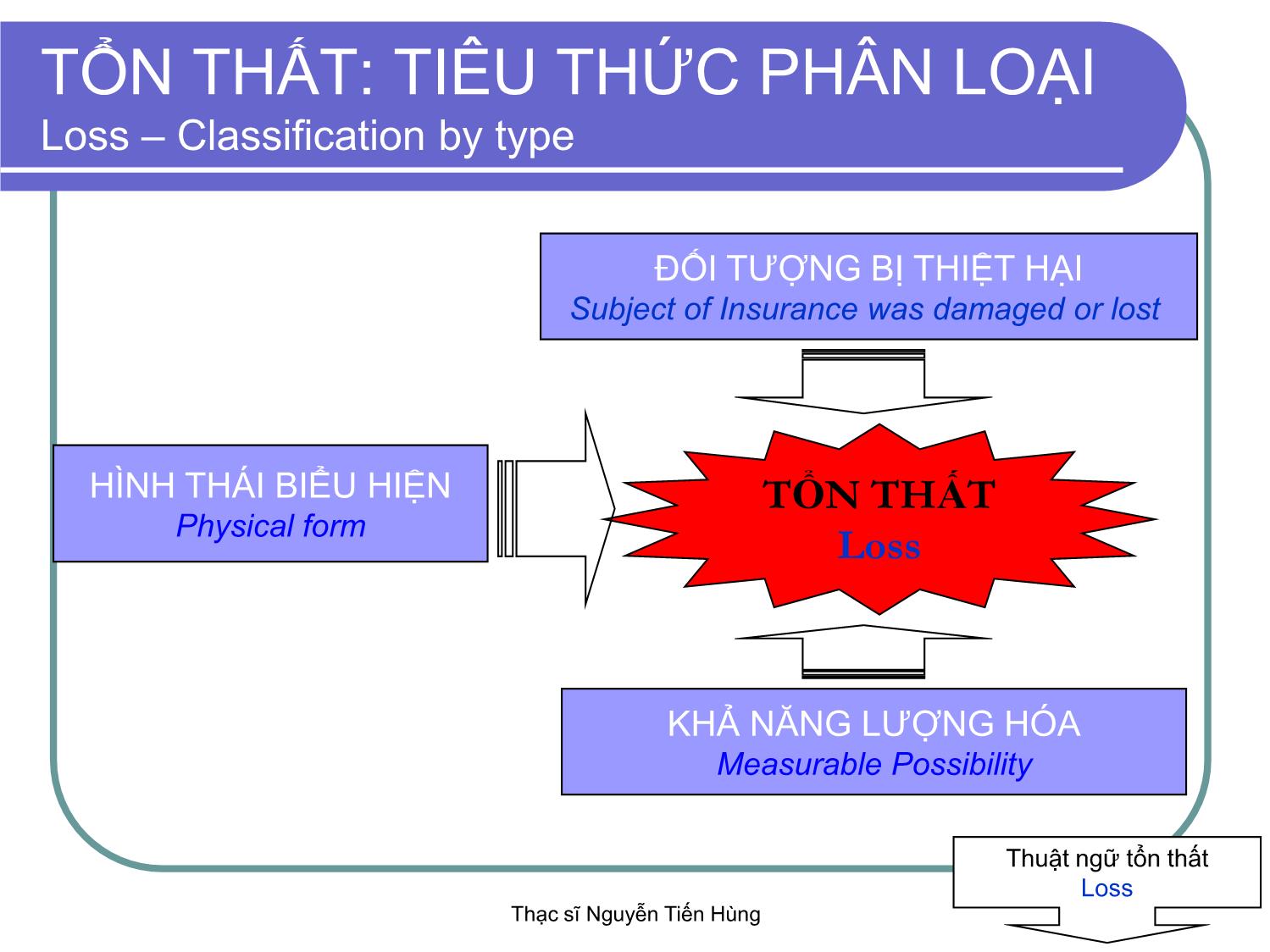
Trang 5
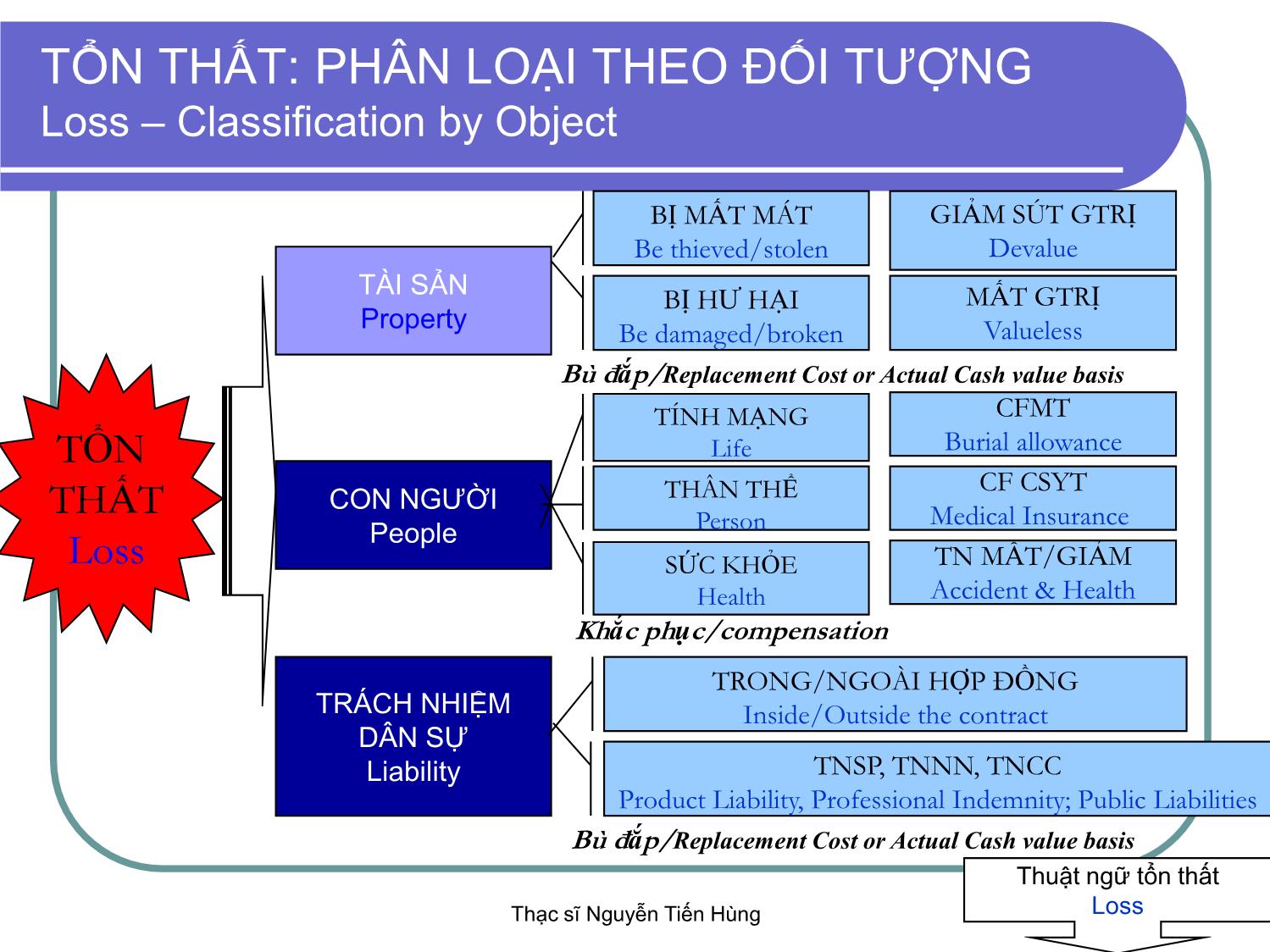
Trang 6
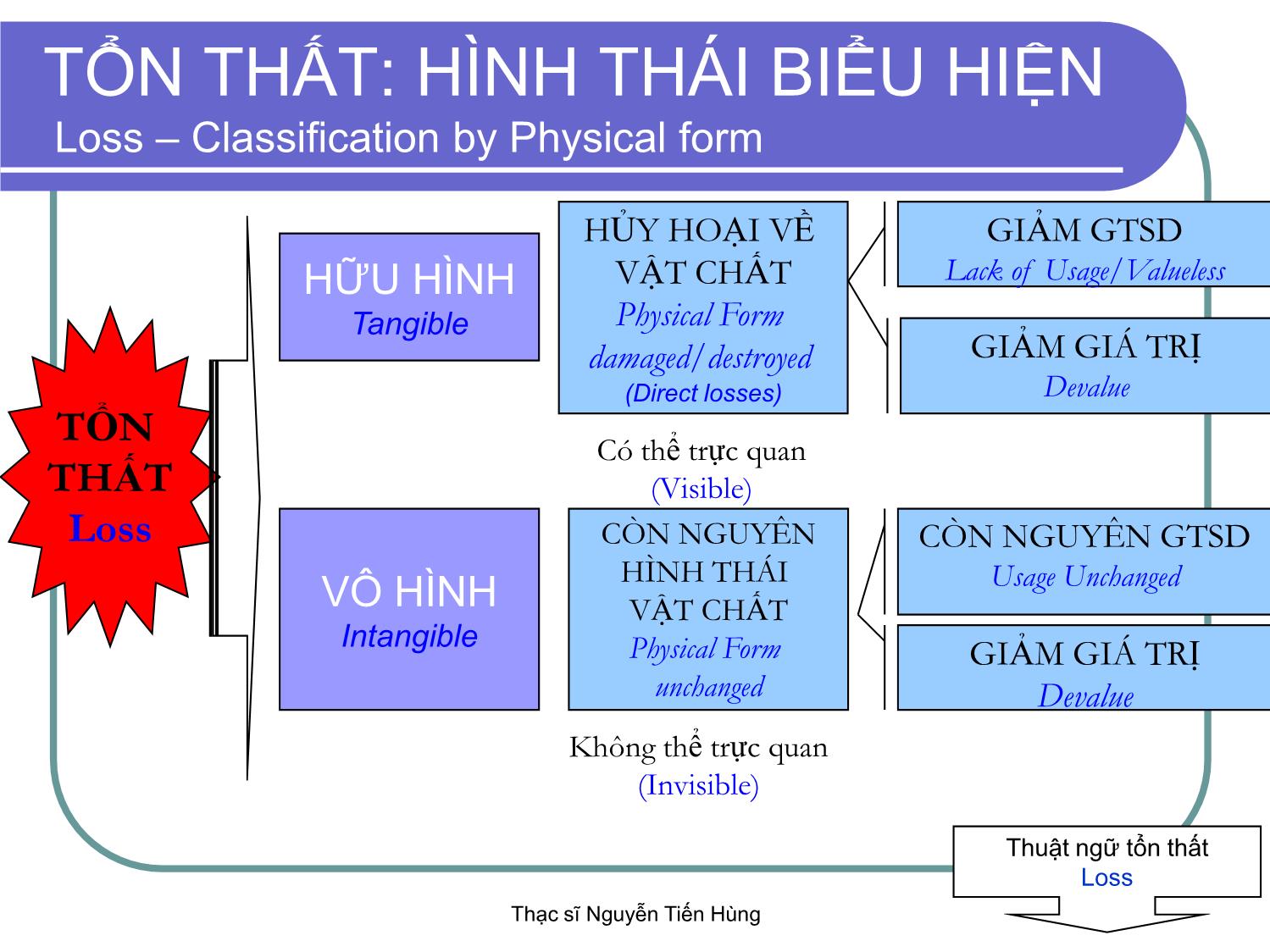
Trang 7
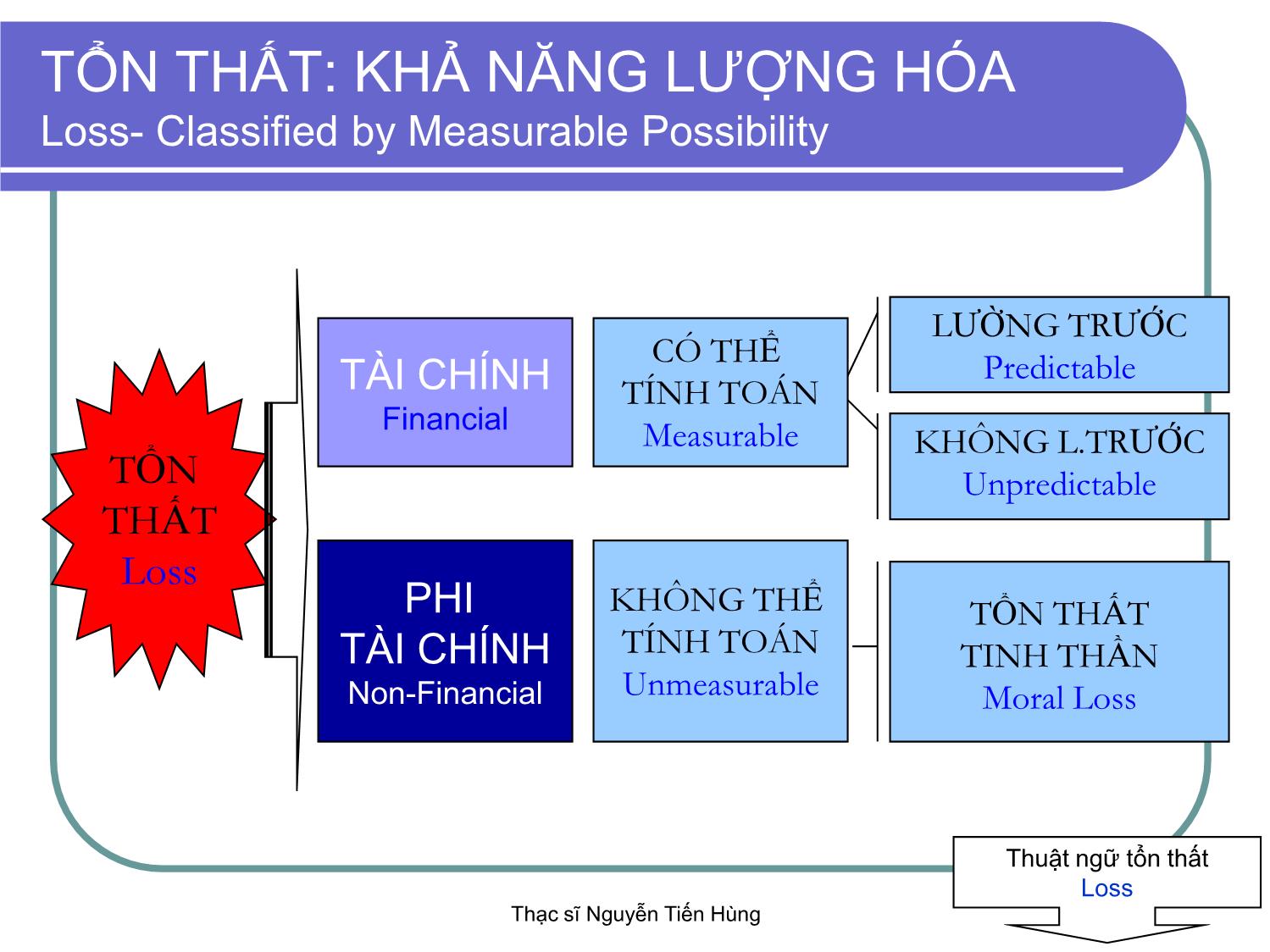
Trang 8
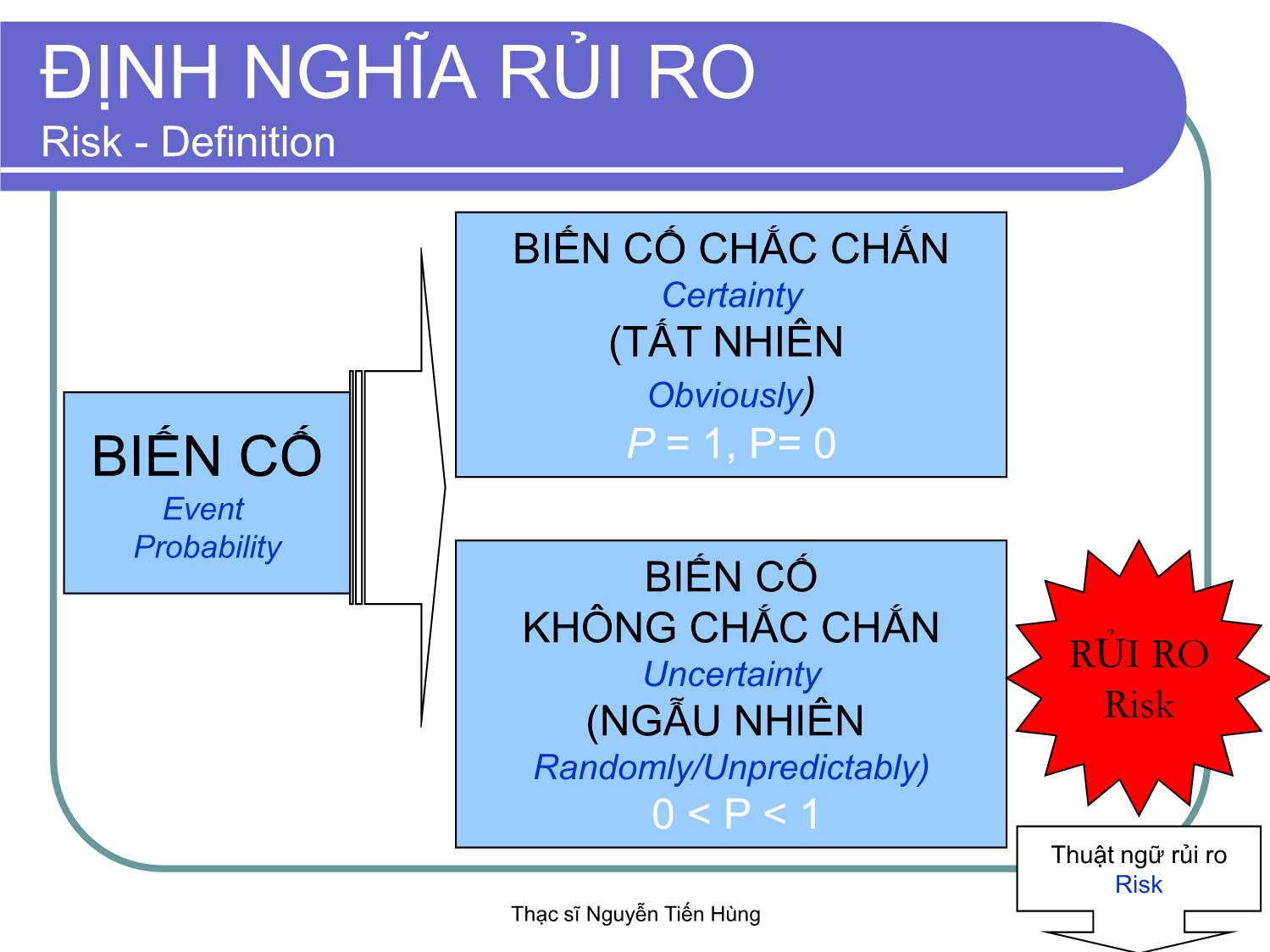
Trang 9
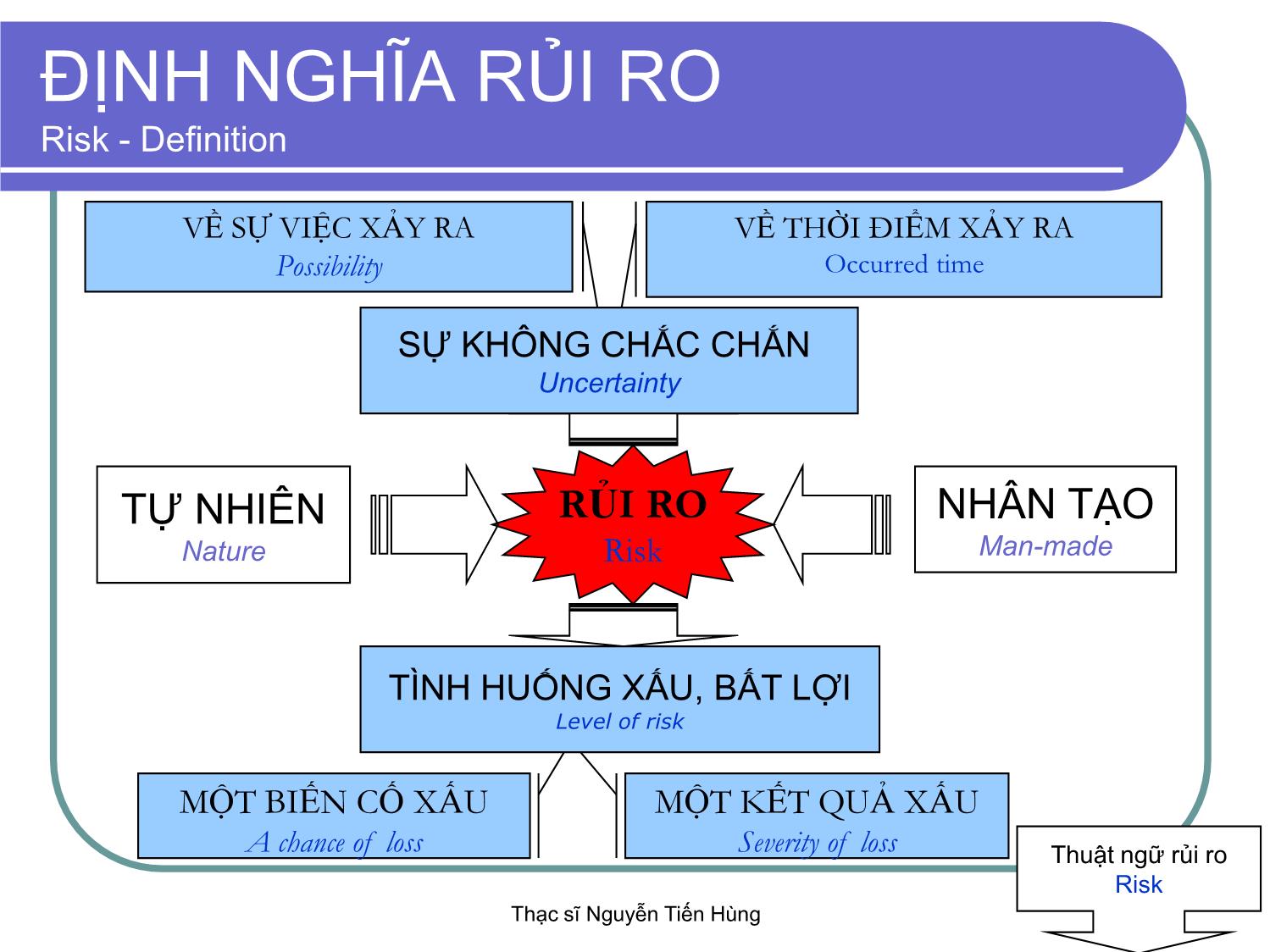
Trang 10
Tải về để xem bản đầy đủ
Tóm tắt nội dung tài liệu: Bài giảng Thị trường bảo hiểm - Module 2 - Nguyễn Tiến Hùng
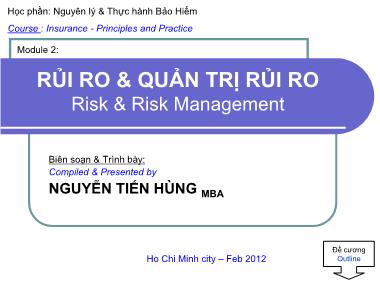
RA TỔN THẤT Influenced by People but not intend to cause the loss CHỦ QUAN Subjective Rủi ro có thể bảo hiểm Insurable Risk Thạc sĩ Nguyễn Tiến Hùng RỦI RO CÓ THỂ BẢO HIỂM Insurable Risk 30 300 3000 LỚN Major/Large number VỪA Minor/a few NHỎ/ KHÔNG CÓ A few/Non MÔ HÌNH TAM GIÁC HEINRICH Heinrich Triangle Rủi ro có thể bảo hiểm Insurable Risk Thạc sĩ Nguyễn Tiến Hùng RỦI RO CÓ THỂ BẢO HIỂM Insurable Risk RỦI RO CÓ BẢO HIỂM THEO LÝ THUYẾT Insurable risks as of theory RỦI RO KHÔNG THÊ BẢO HIỂM Risk can not be insurable PHẠM VI BẢO HIỂM CỦA MỘT SẢN PHẨM BẢO HIỂM Coverage of Insurance Product RỦI RO CÓ THỂ BẢO HIỂM CỦA MỘT DNBH Insurable risk per Insurer RỦI RO CÓ THỂ BẢO HIỂM CỦA TTBH MỘT QUỐC GIA Insurable risk per Insurance market by Country (Dynamic Risks) RỦI RO CÓ THỂ BẢO HIỂM CỦA TTBH THẾ GIỚI Insurable Risk of the World’s Insurance Market Rủi ro có thể bảo hiểm Insurable Risk Thạc sĩ Nguyễn Tiến Hùng PHẠM VI BẢO HIỂM – RỦI RO ĐƢỢC BẢO HIỂM Coverage & Insurable Risk PHẠM VI BẢO HIỂM LÀ MỘT ĐIỀU KHOẢN QUAN TRỌNG TRÊN HĐBH, GỒM NHỮNG RỦI RO MÀ DNBH CHẤP NHẬN ĐẢM BẢO (CÒN GỌI LÀ RỦI RO ĐƯỢC BẢO HIỂM) Coverage is the most vital Clause in the Insurance contract, which list what kind of risk are insured by the Insurer (so-called Insurable Risks) RỦI RO ĐƯỢC BẢO HIỂM Coverage (Insurable risk) • TRƯỚC TIÊN PHẢI LÀ RỦI RO CÓ THỂ BẢO HIỂM First of all, those risk in coverage should be insurable. • ĐƯỢC DNBH CHẤP NHẬN BẢO HIỂM Agreed to insure/assure by the Insurer • NẾU XẢY RA, GÂY THIỆT HẠI CHO ĐTBH, LÀM PHÁT SINH TRÁCH NHIỆM BỒI THƯỜNG/ TTBH CỦA DNBH If Loss occur and damage the Subject of Insurance or Insured, the Indemnity/Claim payment Obligation of Insurer will come. Rủi ro có thể bảo hiểm Insurable Risk Thạc sĩ Nguyễn Tiến Hùng LOẠI TRỪ - RỦI RO LOẠI TRỪ Exclusion of Risk LOẠI TRỪ Exclusion • ĐIỀU KHOẢN QUAN TRỌNG ĐI KÈM ĐIỀU KHOẢN PVBH TRÊN HĐBH, GỒM NHỮNG RỦI RO MÀ DNBH KHÔNG CHẤP NHẬN ĐẢM BẢO (RỦI RO LOẠI TRỪ) Exclusion is the important clause in the Insurance Contract that exclude the Insurance of certain hazard or perils (excluded risk) • ĐẶC BIỆT QUAN TRỌNG TRONG ĐƠN BẢO HIỂM “MỌI RỦI RO” This Clause is very important in “All Risk” Application RỦI RO LOẠI TRỪ Excluded Risk • LOẠI TRỪ TUYỆT ĐỐI: RỦI RO KHÔNG THỂ BH As absolute exclusion : Uninsurable or predictable declines risk • DO KHẢ NĂNG QUẢN LÝ CỦA NGƢỜI BẢO HIỂM As the Ability of the Insurer for Risk management • NẰM Ở PHẠM VI KHÁC NHƢNG HAY NHẦM LẪN In order to avoid misunderstanding • RỦI RO RIÊNG (CÓ THỂ BH NẾU THỎA THUẬN) As particular risks (Can be insured under an agreement). Lịch sử QTRR History of Risk Management Thạc sĩ Nguyễn Tiến Hùng LỊCH SỬ QUẢN TRỊ RỦI RO The Evolution of Risk Management Thuật ngữ “Quản trị rủi ro” ra đời từ sau chiến tranh thế giới thứ 2 đến giữa thập niên 60; The term “Risk management” was formed by the period from World War II to the mid 1960s Những đổi mới và phát triển khoa học kỹ thuật, những rủi ro mới xuất hiện, những rủi ro cũ lại tăng lên. In addition to the Innovation of the science and technology, the new risks appeared and as well as the more increasing of old one. Lịch sử QTRR History of Risk Management Thạc sĩ Nguyễn Tiến Hùng Trƣớc đó, bảo hiểm luôn là phƣơng cách duy nhất đƣợc dùng để đảm bảo cho các rủi ro cổ điển. Before time, Insurance is always the unique method to assure traditional risks. Trong mỗi doanh nghiệp, ngƣời ta phải mua và quản lý vô số hợp đồng bảo hiểm từ một hoặc nhiều nhà bảo hiểm. the insured buyer had to buy and administer a lot of Insurance Contracts by one or many Insurers. Với sự xuất hiện của các rủi ro mới, bảo hiểm có những giới hạn của nó. Together with the occurrence of new risks, Insurance had its own limitation LỊCH SỬ QUẢN TRỊ RỦI RO The Evolution of Risk Management Lịch sử QTRR History of Risk Management Thạc sĩ Nguyễn Tiến Hùng Doanh nghiệp buộc phải tiếp cận rủi ro một cách có ý chí hơn Enterprise were impelled to approach the risks by their strong willingness. Họ tự giác mở rộng trách nhiệm của mình trong việc nhận dạng các rủi ro mới, đƣa ra kỹ thuật đề phòng, tạo ra sự đảm bảo khác ngoài bảo hiểm. They themselves expand their own duties by examining company operations for serious uninsured risk and loss prevention opportunities, suggesting changes in operation in order to avoid risk rather than Insurance Họ quyết định rủi ro nào họ muốn và có thể mua bảo hiểm và rủi ro nào doanh nghiệp tự cáng đáng lấy. They recommended hold-harmless clauses in certain contracts, getting deductibles to insured some bearable risk Chức năng quản trị rủi ro ra đời The Risk Management function evolved. LỊCH SỬ QUẢN TRỊ RỦI RO The Evolution of Risk Management Lịch sử QTRR History of Risk Management Thạc sĩ Nguyễn Tiến Hùng 1955, Wayne Snider - giáo sƣ của Temple University: Khi mà những ngƣời có trách nhiệm mua bảo hiểm trong doanh nghiệp tự giác quan tâm đến và làm chủ rủi ro hơn là hài lòng bằng việc mua bảo hiểm cho chúng, họ sẽ trở thành những “nhà quản trị rủi ro” (Risk Manager). In 1955, Wayne Snider - Professor of Insurance at Temple University suggested since insurance manager were now focusing on risks and ways to control them, rather than merely purchasing insurance, they should be called risk manager. LỊCH SỬ QUẢN TRỊ RỦI RO The Evolution of Risk Management Lịch sử QTRR History of Risk Management Thạc sĩ Nguyễn Tiến Hùng Năm 1956, Russel Gallagher, trong một bài viết đƣợc công bố bởi tạp chí nổi tiếng Havard Business Review (số 34) đã giới thiệu thuật ngữ “Quản trị rủi ro” (Risk Management) với các nhà doanh nghiệp. In 1956, Russel Gallagher, in his writing in the famous Havard Business Review (Vol. 34), introduced the term risk management to the business organizers. LỊCH SỬ QUẢN TRỊ RỦI RO The Evolution of Risk Management Lịch sử QTRR History of Risk Management Thạc sĩ Nguyễn Tiến Hùng Năm 1961, trong quyển “Bảo hiểm, Lý thuyết và Thực hành ở Hoa kỳ”, Ralf Blanchard, cựu giáo sƣ bảo hiểm của Columbia University đã chỉ ra rằng: lĩnh vực áp dụng của quản trị rủi ro là lĩnh vực các “rủi ro thuần” (pure risks). In the 1961 edition of the book named “Insurance, Its Theory and Practice in the United States”, author Ralf Blanchard, retired professor of Insurance at Columbia University proposed that the field of risk management is that of pure risks Ông đƣa ra ranh giới phân biệt giữa rủi ro thuần và các rủi ro đầu cơ (spéculative risks). He cited the factual confinement of the pure risk (risk offering the possibility of loss or no loss) and the speculative risks (offer the chance of loss or gain). LỊCH SỬ QUẢN TRỊ RỦI RO The Evolution of Risk Management Lịch sử QTRR History of Risk Management Thạc sĩ Nguyễn Tiến Hùng 1962, trong tờ National Insurance Buyer (tháng 9/1962) đã giới thiệu một khái niệm cơ bản mới của quản trị rủi ro: Giá phí toàn bộ của rủi ro. In the September 1962 issue of the National Insurance Buyer submitted a new basic concept for risk management : The risk-cost Concept Douglas Barlow: Đối với mỗi rủi ro có thể bảo hiểm, việc tổ chức xử lý tƣơng ứng và phụ thuộc vào bốn loại gíá phí sau: Chi phí đề phòng, Phí bảo hiểm, Tổn thất tự gánh chịu không đƣợc bồi thƣờng từ bảo hiểm, Chi phí quản lý. Douglas Barlow: Each of the insurable risk to which an organization is exposed should be seen as a cost composed of the interrelated factors of cost as of loss prevention , insurance premium, losses sustained net of indemnities from the insurers and third parties and expense of administration. LỊCH SỬ QUẢN TRỊ RỦI RO The Evolution of Risk Management Lịch sử QTRR History of Risk Management Thạc sĩ Nguyễn Tiến Hùng Mục tiêu của quản trị rủi ro trở thành việc tối ƣu hóa giá phí toàn bộ của rủi ro Risk management is aimed to mitigate the cost of the risks effectively. Phải đầu tƣ vào việc đề phòng, dự phòng - tự bảo hiểm để giảm phí bảo hiểm To finance the loss prevention, pre and post-loss risk financing or self- insurance in order for deductible clause Phải phân bổ tốt nhất ngân sách của doanh nghiệp giũa bốn loại cấu thành giá phí của rủi ro. Best practice in Budget’s allocation between four constitute of risks-cost LỊCH SỬ QUẢN TRỊ RỦI RO The Evolution of Risk Management Lịch sử QTRR History of Risk Management Thạc sĩ Nguyễn Tiến Hùng Năm 1950, tại Hoa kỳ, Hiệp hội quốc gia những ngƣời mua bảo hiểm bảo hiểm (The National Insurance Buyers Association) ra đời và sau đó trở thành Hội quản trị rủi ro và bảo hiểm (The Risk and Insurance Management Society – RIMS). In 1950 in United States, the National Insurance Buyers Association established and then rebranded to The Risk and Insurance Management Society - RIMS. Năm 1954 đã công bố tạp chí đầu tiên. In 1954, published the first journal of the Association Năm 1963, tổ chức hội nghị thƣờng niên đầu tiên. In 1963, hold the first Annual Conference Năm 1965, đƣa ra chương trình đào tạo trong lĩnh vực quản trị rủi ro In 1965, launched “the Risk Management Education program” LỊCH SỬ QUẢN TRỊ RỦI RO The Evolution of Risk Management Lịch sử QTRR History of Risk Management Thạc sĩ Nguyễn Tiến Hùng Anh quốc – 1963: thành lập Hiêp hội những nhà quản trị bảo hiểm trong các lĩnh vực công nghiệp và thƣơng mại. England in 1963: Established Association of Insurance Managers in Industry and Commerce - AIMIC. Năm 1967, trong Hội nghị đầu tiên, Hiệp hội nầy đã bàn bạc về vấn đề “tự bảo hiểm”, chỉ rõ xu hƣớng phát triển mới của quản trị rủi ro cho tất cả các nhà bảo hiểm ở Anh quốc. In 1967, in the first meeting, this association discussed about “self-insurance”, pointed out the trend of risk management for insurers in England. Năm 1974, AIMIC đổi tên thành AIRMIC, bằng cách thêm từ “rủi ro” vào tên cũ để trở thành “Hiêp hội các nhà quản trị bảo hiểm – rủi ro trong Công nghiệp và Thƣơng mại”, In 1974, AIMIC renamed to AIRMIC, by adding the word “risk” into their old name as “The Association of Risk-Insurance Managers in Industry and Commerce”. LỊCH SỬ QUẢN TRỊ RỦI RO The Evolution of Risk Management Lịch sử QTRR History of Risk Management Thạc sĩ Nguyễn Tiến Hùng Ở Pháp, Nhóm những ngƣời đƣợc bảo hiểm trong thƣơng mãi và Công kỹ nghệ và Hệp hội những ngƣời phụ trách bảo hiểm của các doanh nghiệp Pháp đã đƣợc thành lập năm 1993. In France, the “Groupement des Assurés du Commerce et de l’Industrie – Gaci” and “Association des chargés d’assurance des entreprises francaises – Acadef” were established in 1993. Tự coi việc phát triển chức năng quản trị rủi ro trong các doanh nghiệp là mục tiêu của mình. The responsibility for risk management function among entrepreneur was their objective. Hợp nhất vào tháng 5-1993 cho ra đời tổ chức Hiệp hội quản trị rủi ro và bảo hiểm các doanh nghiệp. Re-unioned in May 1993 and formed “Association pour le management des risques et de l’assurance de l’ entreprise”. LỊCH SỬ QUẢN TRỊ RỦI RO The Evolution of Risk Management Lịch sử QTRR History of Risk Management Thạc sĩ Nguyễn Tiến Hùng ĐỊNH NGHĨA QUẢN TRỊ RỦI RO Definition of Risk Management “Quản trị rủi ro là một môn học về việc chấp nhận cuộc sống với khả năng các biến cố trong tƣơng lai có thể nguy hiểm” Risk Management is a subject which study about the possibility that a future occurrence may cause harm or losses “Quản trị rủi ro nhằm bảo vệ tài sản của doanh nghiệp, trong điều kiện giá phí hợp lý nhất, chống laị những tổn thất có thể tác hại đến quá trình hoạt động của một doanh nghiệp” Risk Management is to protect the enterprise in such the way to reduce the cost of the loss or no-loss risks, to prevent the loss and the impact of potential financial loss in the business operation. “Quản trị rủi ro là việc quản lý giá phí toàn bộ của các rủi ro có thể bảo hiểm hay không trong một doanh nghiệp”. Risk management is to control the general cost of insurable risks in the company operation Định nghĩa QTRR Definition of Risk Management Thạc sĩ Nguyễn Tiến Hùng ĐỊNH NGHĨA QUẢN TRỊ RỦI RO Definition of Risk Management Các định nghĩa chƣa đạt đƣợc mức độ thống nhất cao. All definitions have not yet got the highest level of agreement Nhiều vấn đề mới lại đƣợc đặt ra: Many challenges expose such as: Liệu có còn ý nghĩa không việc phân loại rủi ro thuần và rủi ro đầu cơ? Whether it is still meaningful to classify “pure risk “ and “speculative risk” Quản trị rủi ro phải chăng là một phƣơng pháp, một khoa học, hay một nghệ thuật? Risk management is a method , a science or an art? Phạm vi áp dụng của nó phải chăng chỉ giới hạn trong những rủi ro có thể bảo hiểm, chỉ trong phạm vi doanh nghiệp hay có thể mở rộng đối với các hình thức tổ chức khác? The risk management concept was developed in the managing of insurable risks, is it a new principle applicable to management generally? Ngƣời quản trị rủi ro liệu có thể thật sự thực hiện chức năng quản trị rủi ro một cách độc lập không? Risk managers can implement the function of risk management independently? Khái niệm quản trị rủi ro chƣa bị “đông” lại mà sẽ còn phát triển. The concept for risk management was not a buzz word but in future development Định nghĩa QTRR Definition of Risk Management Thạc sĩ Nguyễn Tiến Hùng CHIẾN LƢỢC QTRR Risk Management Strategy Chiến lƣợc QTRR Risk Management Strategy Thạc sĩ Nguyễn Tiến Hùng CHIẾN LƢỢC QTRR Risk Management Strategy Khaû naêng xaûy ra Frequency Möùc ñoä nghieâm troïng Level of Severity Cao High Thaáp Low Cao High Traùnh neù Risk Avoidance Giöõ laïi, Ñeà phoøng haïn cheá Controlling losses Giöõ laïi Risk Retention Chuyeån giao – Mua baûo hieåm Risk transfer/Buy Insurance Chiến lƣợc QTRR Risk Management Strategy Thạc sĩ Nguyễn Tiến Hùng MỤC TIÊU CỦA QTRR Objective of Risk Management Nhận dạng các rủi ro có thể có đe dọa “tài sản” của doanh nghiệp; Identifying and assessing all of the company risks and taking actions to protect a company against them. Thu thập dữ liệu, xử lý thông tin nhằm đo lƣờng, đánh giá những rủi ro đó; Identifying exposures to potential losses, measuring these exposures. Đƣa ra giải pháp xử lý rủi ro không chỉ bằng việc hoán chuyển cho nhà bảo hiểm thƣơng mại mà còn bằng một hệ thống các kỹ thuật xử lý đồng bộ khác. Decide how to protect the company from harm given the nature of the risks and the company's goals and resources; consider different methods for controlling or preventing risks not only by risk transferring to other insurer but also by a comprehensive enterprise risk management (ERM) system Mục tiêu QTRR Objective of Risk Management
File đính kèm:
 bai_giang_thi_truong_bao_hiem_module_2_nguyen_tien_hung.pdf
bai_giang_thi_truong_bao_hiem_module_2_nguyen_tien_hung.pdf

